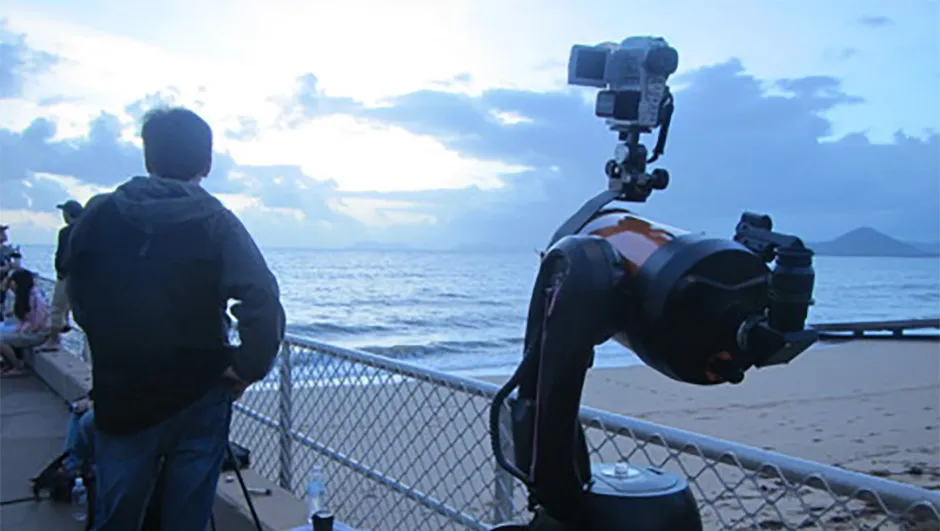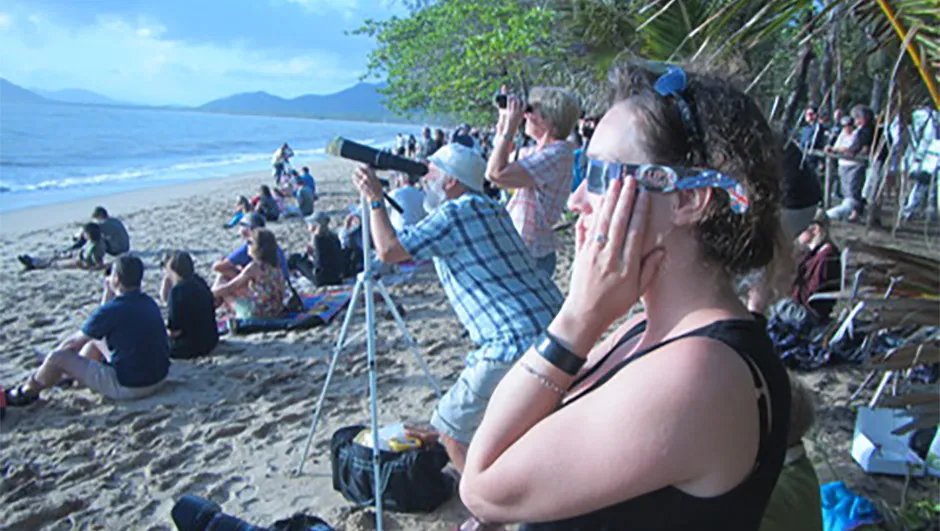Despite an uncertain start, Queensland's total solar eclipse did not disappoint. Image Credit: Anik De Groof
The beaches of northern Queensland, Australia were crowded from dawn this morning, 14 November, to witness a truly spectacular total solar eclipse - complete with Diamond Ring - above an ocean horizon that had been thick with cloud just minutes before.
Just after dawn had wiped out the Southern Cross and a bright Venus, low heavy cloud blocked out the first glimpses of first contact at 5.44am, and the hope of a clear view of totality just 54 minutes later were small on a busy, though not crowded Palm Cove.
It was clear above the Sun and Moon, and on the horizon, but by 6.20am a bank of thick cloud moved inland and over Palm Cove; the Sun was rising fast, but the cloud was edging in front.
By 6.38am however, the clouds had parted just enough for a wonderfully clear view of totality - two minutes, three seconds of darkness in the Moon's umbral shadow.
"About 20 minutes past the hour I thought 'this is a no show' and I got a bit complacent," said Michael Price, an amateur astronomer from Halesowen, "but then the clouds started to clear and I suddenly thought that we might have a chance.
I don't know if it was an optical illusion, but totality looked larger, probably because it was closer to the horizon."
"It was a cracking eclipse - one of the most spectacular I've seen," said David Philips, Operations Manager at Explorers, who's now witnessed four total eclipses.
"There was tremendous detail in the corona and there were several solar flares visible during totality.
The Diamond Ring illuminated some cloud beautifully - it was a really nice effect."
Of the appearance of Venus, Philips added:
"It was the first time I've been able to see a planet during an eclipse - it appeared a few minutes before totality."

This particular eclipse had some other rare gems.
"The Baily's Beads going in we're really lovely," said astronomer Dr John Mason, who led over 200 Brits on a trip to Palm Cove with Explorers.
"We had lots of prominences including a lovely arch prominence that became visible towards the end of the eclipse.
The Diamond Ring was the thing that really made it for me because of the colours given to the first bead by the chromosphere - the whole beach went a pinky orange for a second or two, and the clouds around the eclipsed Sun caught the light. It was just wonderful.
"The corona was fairly typical for a solar maximum eclipse - bright and spiky all the way round, with lots of little prominences," added Dr Mason.
It was Dr Mason's fifteenth eclipse, but others were getting their first glimpse of one of nature's most spectacular events.
"I know I was supposed to look around for planets and shadow bands, but I was totally fixated on the Sun," said Gill Cooper, an amateur photographer from Cardiff who videoed totality to extract images later so she could watch her first total eclipsewith the naked eye.
"The Sun's corona was amazing, just mesmerizing - it was irregularly striped like a zebra, as if overlapping ribbons were pulsing in a breeze.
I could have burst into tears, it was so emotional."
Committed
Umbraphiles had gathered from late the previous night; I spotted a group of young Japanese men playing cards at midnight while sheltering from a tropical rainstorm.
We arrived on the beach at 4.00am with raincoats, umbrellas, waterproof camera covers and plastic bags all primed for use.
First contact at 5.45am was invisible, and the following 30 minutes was stress defined; most had lost hope of seeing this eclipse, which seemed destined to become nothing more than million-dollar darkness.
Though a huge bank of cloud moved overhead at 6.20am to worsen moods, just a few minutes later Palm Cove had full sight of the partial eclipse for the first time, and solar eclipse glasses were hastily donned.
It was a brief sighting, but hopes were raised; could we actually see totality despite the rainy season starting just days ago?
At 6.32am - with just six minutes to go until second contact and totality - the Sun and Moon had risen to the height of the highest cusp of cloud.
Four minutes later the light began to drop, revealing a bright Venus to the Sun and Moon's top left.
Shadows lengthened and the southeast horizon was tinged with orange and pink and spreading fast.
After so much cloud and days of negativity, a clear view of totality now looked a most unlikely, tantalizing possibility.

Light dwindled to eery twilight as the sunshine on the ocean ceased, and then darkness.
The shadow of the Moon rushed over us from behind as Baily's Beads were visible on the Moon's bottom-right.
And there it was - the Sun's corona, distant but captivating, so much so that I spent at least half of totality - which lasted just over two minutes - without binoculars.
There was screaming, followed by an awed silence.
What was immediately striking was the eclipsed Sun's place in a huge sky, with Venus shining bright above a quickly lightening horizon.
With some 10x50 binoculars fixed on the Moon, wispy, textured spirals made the Sun's bright white corona look almost like an oil painting.
It was possible to make out a major orangey-red prominence at the 10 o'clock position, then another, with the orangey chromosphere itself visible as this short eclipse began its end.
Then more Baily's Beads stretched across the sphere before a spectacular pulsing Diamond Ring broke out.
Third contact achieved, Palm Cove was then treated to the ultimate 'warm down', an almost completely clear partial eclipse as the beach warmed up and the tide rushed in. Fourth contact at 7.40am was obscured, but nobody on Palm Cove was complaining.
From the jaws of disappointment we had all experienced a celestial bullseye up close.
Jamie travelled with Explorers Astronomy Tours, which organises astronomy and stargazing trips around the world. Its next total solar eclipse tour is to the High Arctic in March 2015.